Services on Demand
Journal
Article
Indicators
-
 Cited by SciELO
Cited by SciELO
Related links
-
 Similars in
SciELO
Similars in
SciELO
Share
Revista Peruana de Medicina Experimental y Salud Publica
Print version ISSN 1726-4634
Rev. perú. med. exp. salud publica vol.37 no.1 Lima Jan./Mar 2020
http://dx.doi.org/10.17843/rpmesp.2020.371.4580
Original Article
Socio-demographic factors and early life events associated with happiness in adults of Metropolitan Lima
1 Instituto Nacional de Salud Mental “Honorio Delgado - Hideyo Noguchi”, Lima, Perú.
2 Facultad de Medicina, Universidad Peruana Cayetano Heredia, Lima, Perú.
INTRODUCTION
Happiness corresponds to the area of psychology linked to positive health. Emotions such as happiness, contentment or enjo yment expand the repertoire of “thought-action” of people at any given time, therefore, they become more durable personal resources and would serve to prevent and treat problems rooted in negative emotions, such as anxiety, depression or others related to stress 1. Positive health has also been found to be linked to biological correlations such as survival in people with coronary heart disease 2, and even longevity 3. Other authors claim that economic growth is not necessarily associated with happiness. Therefore, the latter is a population priority and a need for research 4.
The World Happiness Report, a publication of the General Assembly of the United Nations, used two questions to estimate happiness in countries (“in general, how happy are you?”; and “taking all your life into account, how satisfied do you feel?”) and found out that Peru ranked 65th out of 104 countries, and 9th in Latin America, just ahead of Venezuela. According to this study, the external factors that determined happiness were income, work, satisfaction with the community and governance, values and religion; and the personal factors —physical and mental health, family experience, education, sex and age 5. This study found that rich countries tended to be happier, although social factors such as strength of social support, absence of corruption and personal freedom were more important for happiness than income. Other studies have related adverse early experiences and parenting styles to subjective well-being in adulthood, although less so to feelings of happiness 6-8.
KEY MESSAGES
Motivation for the study: Public health has placed emphasis on studying negative aspects of health. Less attention has been given to the study of factors associated with people’s well-being and positive health aspects such as happiness.
Main findings: Happiness in adults was associated with sex, marital status, education and poverty level. Happiness was also associated with received parenting styles and early life events.
Implications: Both negative and positive early life events can have implications for the development of happiness in individuals.
As far as we know, there are no other population studies in the region that have specifically explored the feeling of happi ness and its relationship with early experiences. Therefore, the objective of this study was to estimate the socio-demographic factors and early life events associated with happiness in the adult population of Metropolitan Lima.
MATERIALS AND METHODS
Study design
The present secondary analytical cross-sectional study used the database of the Epidemiological Study of Mental Health in Metropolitan Lima and Callao (EESMLMC in Spanish), a survey conducted in 2012 using a representative sample of adults in Metropolitan Lima, selected through a three-stage probabilistic process 8.
Instruments
The following instruments were used in this study and they have been validated in previous studies conducted by the National Insti tute of Mental Health (INSM in Spanish) in different regions of Peru 9:
Mezzich’s Quality of Life Index. It is composed of 10 dimensions, which evaluate aspects related to the quality of life. Each item is to be rated on a 10-point line.
Summarized and modified version of My memories of upbringing or EMBU (Egna Minen av Bardoms Uppfostran). In previous INSM studies, they prepared a summarized version of 13 questions, and then they added 5 questions about “machis mo”, personal autonomy, overprotection and control without affection 8. The internal consistency of this psychometric analy sis of 18 questions was of 0.74 as per the Cronbach Alpha. Three dimensions were identified —affective attitudes (rejection or affection), sibling favoritism, and overprotection or demands 9.
Negative life events before the age of 18. The study included 8 situations of adverse life events related to threats and living conditions determined by other parental behaviors. The INSM experts considered that said situations were important in the country context (Table 5).
Table 5 Adverse life events associated with happiness in adults in Metropolitan Lima
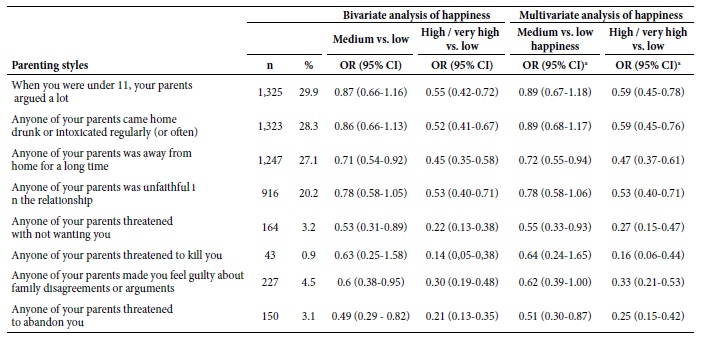
a Adjusted for sex, marital status, education and poverty
CI: confidence interval
Andrews’ Happiness Item (IUFA) 10. A single question with categorical and polytomous answer options. In a score from 1 to 5, 5 is the highest feeling of happiness —Would you describe yourself as happy and interested in life? (5 points), somewhat happy? (4 points), somewhat unhappy? (3 points), unhappy and with little interest in life? (2 points), so unhappy that life has no meaning? (1 point).
Diener’s Satisfaction with Life Scale (SWLS) 11,12. There are 5 items on a 5-point Likert scale that measure the perception of satisfaction with one’s life. The score goes from 5 to 25, and 15 is considered a neutral score. Finally, we obtain 5 categories very dissatisfied (5-9), dissatisfied (10-14), neither satisfied nor dissatisfied (15), satisfied (16-20), and very satisfied (21-25). For this study, scores from 1 to 5 were reassigned to the categories according to the level of satisfaction, where one point corresponded to extremely dissatisfied and five points to extremely satisfied.
Happiness Index (HI). This index results from the addition of IUFA scores to the SWLS reassigned scores mentioned above. Therefore, the HI score was from 2 to 10. The cut-off points were intentionally set by taking the extremes first, i. e., those people who responded to the IUFA as “somewhat unhappy” (3 points) and “neither satisfied nor dissatisfied” (3 points) in the SWLS score were considered to be people with low happiness, with a score of 6. Thus, “low happiness” was determined when the score was 6 or less in the HI and it included people who were considered so unhappy that life had no meaning and were dissatisfied with life; “high or very high happiness” when the responses to one of the instruments had a maximum score of 5 and the other instrument at least a score of 4 (9 10 points); and “medium happiness” (7 8 points) for the rest of the combinations of responses with both instruments. The study was programmed to estimate the convergent validity of the index created and its categories (supplementary material).
Demographic data and poverty indicators. They included questions from the National Household Survey (ENAHO in Spanish) 2000 (13 about age, sex, marital status, educational level, employment situation, area of residence and the assigned healthcare system, in addition to variables for calculating poverty, according to the unsatisfied basic needs (UBN) method, such as housing characteristics, etc. (14) The presence of two or more UBNs corresponds to families in extreme poverty, one UBN to poor families and the absence of UBNs to non-poor families.
Statistical analysis
The sample was weighted to reproduce the demographic structure of the population studied. Since the HI was created for this study, it was decided to evaluate the convergent validity by estimating its association with the Mezzich’s quality of life index, following theoretical suggestions around these two constructs 15, as well as the type of statistical analysis required 16. The HI was categorical and the quality life index numerical, so we used the analysis of variance (ANOVA) which, in the case of com plex samples, implies the use of SPSS general linear model.
In order to estimate the association between HI and socio demographic variables and to identify the variables to be inclu ded in the regression models, we performed bivariate analyses with chi-square tests converted to the F statistic as a variant of the second-order Rao-Scott corrected chi-square statistic and the significance based on their degrees of freedom and a signi ficance level of p<0.05. For multivariate analysis we considered HI as a response variable, and socio-demographic variables, quality of life, parenting styles and adverse life events as predicting variables, each one separately. In each case, it was adjusted with the socio-demographic variables identified at the beginning with a significance level of p<0.05. We ensured that the pre dicting variables met the non-multicollinearity assumption. Multivariate logistic regression analyses were included to estimate the adjusted OR and to have a better possibility of interpretation of the relationship between the factors studied at each level of happiness.
Ethical considerations
The original study was approved by the Ethics Committee of the National Institute of Mental Health “Honorio Delgado - Hide yo Noguchi” and the informed consent was signed by the persons interviewed. The present study was presented to the referred committee looking for an exoneration from review because it performs a secondary analysis of a database. The database used for this study was anonymized.
RESULTS
A total of 4445 adults were interviewed. The weighted sample was distributed to 48.0% men and 52.0% women. The average age was 42.6 years (95% CI, 41.8-43.3). Most of the people surveyed were married or cohabiting (56.6%) with high school education (44.8%); an illiteracy frequency of 3.1% (95% CI, 2.5-3.8). 63.7% (95% CI, 61.9-65.4) of the sample had a paid job the previous week; and 21.5% of the population was in poverty according to UBN.
According to the HI, 8.4% (95% CI 7.4-9.4) of the population expressed low or no happiness; 29.9% (95% CI 28.1-31.7) had a medium level of happiness; and 61.7% (95% CI 59.7-63.7) of the population manifested high or very high happiness. The type of happiness reported at the time of the survey according to socio-demographic factors is shown in Table 1.
Table 1 Socio-demographic characteristics according to levels of self-reported happiness by adults in Metropolitan Lima
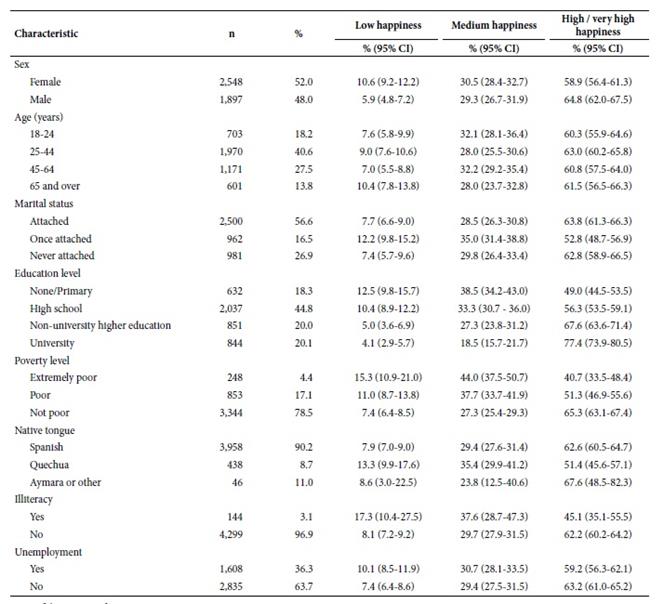
CI: confidence interval
The bivariate analyses showed a significant association with sex, marital status, educational level, poverty level, native ton gue, illiteracy and unemployment, with the exception of age. However, in the multivariate analysis, the native tongue, illiteracy and unemployment variables did not continue to show significant differences. With respect to sex, it is observed that men are 1.79 times more likely to have “high or very high happiness” over “low happiness” compared to women. The group that was once attached (separated, divorced or widowed) shows a lower probability of having “high happiness” compared to people who were attached (married or cohabiting). People with higher education are 3.18 times more likely than people with lower education to have “high happiness” versus “low happiness”. Non-poor people are 2.54 times more likely than extremely poor people to have “high or very high happiness” versus the “low happiness” category (Table 2).
Table 2 Socio-demographic characteristics associated with happiness in adults in Metropolitan Lima
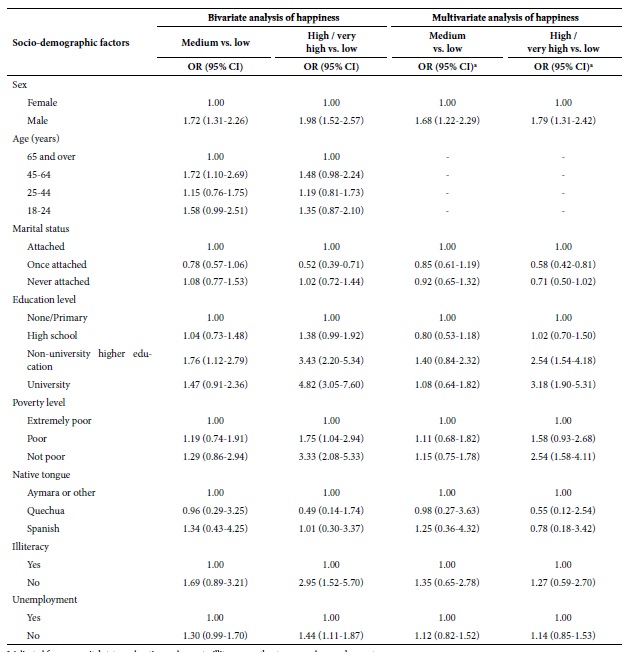
a Adjusted for sex, marital status, education and poverty, illiteracy, mother tongue and unemployment
CI: confidence interval
It was found that there is a significant relationship between the quality of life index dimensions and the HI according to the scores obtained in the bivariate analysis and between each of the categories adjusted with socio-demographic variables (Table 3).
Table 3 Quality of life associated with happiness in adults in Metropolitan Lima
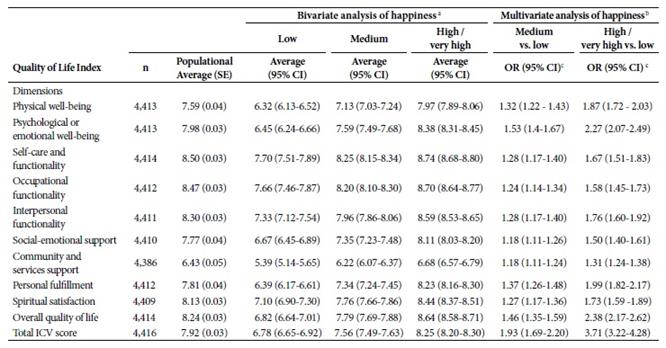
a ANOVA; b multinomial regression; c adjusted for sex, marital status, education and poverty
SE: Standard error
CI: confidence interval; SE: standard error
Some of the parenting style variables are inversely linked to happiness, especially those related to rejection and “macho” attitudes, and directly linked to styles involving emotional warmth. Among the variables with a more intense association there is “you were given more punishments than deserved”. On the other hand, the positive style most strongly associated with happiness was “there was love and tenderness between you and your parents”, people with this background were 3.18 times more likely to have high or very high happiness. No parenting styles that involved favoritism or overprotection were statistically associated with happiness (Table 4).
Table 4 Parenting styles associated with happiness in adults in Metropolitan Lima
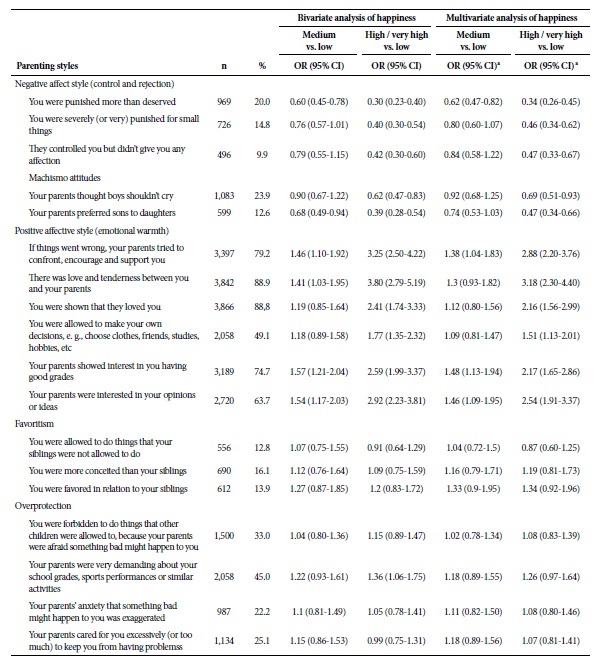
a Adjusted for sex, marital status, education and poverty
CI: 95% confidence intervals
With respect to adverse life events all the situations considered showed a significant association and an intense inverse relationship with happiness, highlighting situations such as “one of your parents threatened to kill you” and “one of your parents threatened to stop loving you” (Table 5).
DISCUSSION
The present study is one of the first in Peru to relate the variables exposed. The study provides evidence about the importance of the relationship between socio-demographic aspects and happiness, as well as elements of personal history that could influence in people’s emotional future.
A large proportion of Lima’s adult population considers themselves to experience a high or very high level of happiness. These findings are similar to the Survey on Happiness, Hope and Economic Optimism, conducted by Gallup International, which found that 59% of the world’s population reported feeling happy, or very happy, Latin America showed 69% 17. With respect to socio-demographic variables, this study found a significant association with sex, marital status, educational level and poverty. These findings are compatible with another study conducted in Iran 18. Other variables such as illiteracy, native tongue and unemployment, although significantly associated with happiness in the bivariate analyses, did not retain the as sociation at the time of comparing to other socio-demographic variables. Likewise, some studies did not find any association between sex and happiness 19.
With regard to the relationship between poverty and happiness, some authors postulate that the perception of social diffe rences with other people leads to the search for satisfying material or physical needs that affect, to the detriment of the time dedicated to social relations, which are considered to generate happiness in people 4. However, we must emphasize that a sig nificant proportion of people in extreme poverty were at the level of high or very high happiness. Some authors highlight that the situation of poverty can favor collectivism or the propensity to integrate into social groups and would explain why some poor countries would have a higher perception of happiness than some rich countries 20.
In relation to quality of life and happiness, this study set out to analyze the relationship between both variables as a way of validating the HI —used as an instrument to measure happiness, and found a significant association between all the dimen sions of the quality of life index and the levels of happiness and corroborated other authors’ proposals regarding the correlation between the variables 15. This relationship is also expressed in the findings that would indicate that happiness is associated with diverse results of success in work, income, community involvement, interpersonal relationships, and health in general, all related to the concept of quality of life 21.
With respect to parenting styles, early adverse events are not only associated with mental disorder problems in adulthood 22, but are also associated with aspects of positive health, such as happiness. A study of 3,292 people in Japan found out that adverse expe riences in childhood were related to subjective well being in adulthood, regardless of socio economic factors 7. In contrast, the study developed by Caycho and collaborators from Lima university students 6 found no significant relationship between happiness and overprotective and favoring parenting styles. One explanation may lie in the age and socio economic context of the participants, since Caycho’s study was conducted on young adults from private universities. However, it cannot be ruled out that the relationship between adverse events in childhood and happiness is mediated by other factors. In this sense, one study reported that self-esteem is an important moderator between parental styles and happiness and that the mother’s democratic style, linked to self-esteem, was the most associated with happiness.
A negative relationship was found between adverse life events and happiness. These findings are consistent with a community study that reported a relationship between the intensity of abuse in childhood and the state of mental health in adulthood 23. Other authors have found that childhood abuse is negatively correlated with various indicators of adult well-being, self-esteem, happiness and life satisfaction 24. One explanation for this relationship may be that early traumatic experiences have been asso ciated with emotional dysregulation 25, and follow-up studies of emotional dysregulation in childhood 14 years later reported a greater increase of emotional problems in adulthood 26. A study of 17,337 primary care adults showed a cumulative effect of adverse experiences in childhood on various emotional and behavioral domains in adulthood, which could possibly explain the reduced happiness of people who lived adverse events in childhood 27.
Within happiness, it has been considered to develop tolerance 28, to nurture spirituality, to give priority to close relationships, acting positively in the face of circumstances, managing stressful emotions, providing a pleasant physical environment, promoting healthy physical activities, seeking jobs compatible with their abilities, including recreation, not making comparisons, and caring about others 29. Little attention is given in primary care to the identification of adverse experiences in childhood, despite the impact it has 30. Putting happiness at the center of government policy is suggested by the fact that economic growth in developed countries has not been accompanied by improvement in happiness surveys. However, controversies related to high subjectivity still persist 31.
The results of this study should be considered with the following limitations —the happiness indicator used was created for this study and, despite having evidence of its convergent validity, other validation studies may be necessary; this study explored only some aspects of early events and some parenting styles, and did not integrate all the factors that may mediate and be important for happiness. Likewise, we cannot dismiss the influence of memory and social desirability in interviewees’ responses.
In conclusion, the findings show the importance of both negative and positive early life events for developing happiness and contribute with relevant information for a paradigm shift in the study of mental health with a public health approach not focused on diseases but on health as a whole. This study adds evidence on the importance of developing programs aimed during the first years of life, with promotional and preventive measures in the development of healthy parenting behaviors and environments conducive to the welfare of people’s life.
REFERENCES
1. Fredrickson BL, Tugade MM, Waugh CE, Larkin GR. What good are positive emotions in crises? a prospective study of resilience and emotions following the terrorist attacks on the united states on september 11th, 2001. J Pers Soc Psychol. 2003; 84(2): 365-376. [ Links ]
2. Hoen PW, Denollet J, de Jonge P, Whooley MA. Positive affect and survival in patients with stable coronary heart disease: findings from the Heart and Soul Study. J Clin Psychiatry. 2013;74(7):716-22. [ Links ]
3. Koopmans TA, Geleijnse JM, Zitman FG, Giltay EJ. Effects of Happiness on all-cause mortality during 15 years of follow-up: The Arnhem Elderly Study. J Happiness Stud. 2010; 11(1):113-124. [ Links ]
4. Stillwell F, Jordan K. Economic Inequality and (Un)happiness. Social Alternatives. 2007; 26(4):16-21. [ Links ]
5. Helliwell JF, Layard R, Sachs JD. World Happiness Report 2018. New York: Sustainable Development Solutions Network; 2018. Disponible en: https://s3.amazonaws.com/happiness-report/2018/WHR_web.pdf. [ Links ]
6. Caycho Rodríguez T, Contreras Paredes K, Merino Soto C. Percepción de los estilos de crianza y felicidad en adolescentes y jóvenes de Lima Metropolitana. Perspect Fam. 2016; (1):11-22. [ Links ]
7. Oshio T, Umeda M, Kawakami N. Childhood Adversity and Adulthood Subjective Well-Being: Evidence from Japan. J Happiness Stud. 2013; 14:843-860. doi 10.1007/s10902-012-9358-y. [ Links ]
8. Instituto Nacional de Salud Mental. Estudio Epidemiológico de Salud Mental en Lima Metropolitana y Callao - Replicación 2012 - Informe General. Anales de Salud Mental. 2013; 29 (Suplemento 1): 1-392. [ Links ]
9. Instituto Nacional de Salud Mental. Confiabilidad y validez de los cuestionarios de salud mental de Lima y de la Selva Peruana. Anales de Salud Mental 2009; XXV (Supl. 1): 1-259. [ Links ]
10. Andrews FM. Social Indicators of Perceived Life Quality. Social Indicators Research. 1974; 1: 279-299. [ Links ]
11. Pavot W, Diener E. Review of the Satisfaction with life scale. Psychological Assessment 1993; 5 (2):164-172. Doi: 10.1007/978-90-481-2354-45. [ Links ]
12. Ly G. Atribuciones causales de la satisfacción con la vida en un grupo de adultos de Lima [Tesis de Licenciatura en Psicología]. Lima: Pontificia Universidad Católica del Perú; 2004. [ Links ]
13. INEI. Manual de la Encuestadora de la Encuesta Nacional de Hogares 2000 IV trimestre Oct 2000. Lima: INEI; 2000. [ Links ]
14. Feres JC, Macero X. Enfoques para la medición de la pobreza. Breve revisión de la literatura. Santiago de Chile: UN; 2001. [Citado el 3 de noviembre de 2005] Disponible en: http://www.eclac.org/publicaciones/Estadisticas/9/lcl1479/lcl1479e.pdf. [ Links ]
15. Susniene D, Jurkauskas A. The Concepts of Quality of Life and Happiness - Correlation and Differences. Inzinerine Ekonomika-Engineering Economics. 2009; 3: 48-55. [ Links ]
16. Loewenthal KM. The final scale and its validation. En: Autor. An introduction to psychological tests and scales. London: UCL Press Limited; 1996. p. 55-60. [ Links ]
17. Gallup International. Happiness, Hope, Economic Optimism [Internet]. Washington DC: Gallup International; 2017 [citado el 31 de mayo del 2019]. Disponible en: http://www.gallup-international.com/wp-content/uploads/2017/12/2017_Happiness_Hope_Economic-Optimism.pdf. [ Links ]
18. Azizi M, Mohamadian F, Ghajarieah M, Direkvand-Moghadam A. The Effect of Individual Factors, Socioeconomic and Social Participation on Individual Happiness: A Cross-Sectional Study. J Clin Diagn Res. 2017;11(6):VC01-VC04. doi: 10.7860/JCDR/2017/24658.9982. [ Links ]
19. Mukherjee D, Basu S. A Study of Contributory Factors of Happiness. Indian Journal of Positive Psychology. 2012; 3(2): 136-142. [ Links ]
20. Borrero S, Bolena Escobar A, Cortes AM, Maya LC. Poor and distressed, but happy: situational and cultural moderators of the relationship between wealth and happiness. Estudios Gerenciales [Internet]. 2013 [citado el 31 de mayo del 2019]; 29 (126):2-11. Disponible en: http://www.scielo.org.co/pdf/eg/v29n126/v29n126a02.pdf. [ Links ]
21. Lyubomirsky S, King L, Diener E. The Benefits of Frequent Positive Affect: Does Happiness Lead to Success?. Psychological Bulletin. 2005; 131(6):803-855. [ Links ]
22. Green JG, McLaughlin KA, Berglund PA, Gruber MJ, Sampson NA, Zaslavsky AM, Kessler RC. Childhood adversities and adult psychiatric disorders in the national comorbidity survey replication I: associations with first onset of DSM-IV disorders. Arch Gen Psychiatry. 2010;67(2):113-23. doi: 10.1001/archgenpsychiatry.2009.186. [ Links ]
23. Edwards VJ, Holden GW, Felitti VJ, Anda RF. Relationship between multiple forms of childhood maltreatment and adult mental health in community respondents: results from the adverse childhood experiences study. Am J Psychiatry. 2003;160(8):1453-60. [ Links ]
24. Herrenkohl TI, Klika JB, Herrenkohl RC, Russo MJ, Dee T. A prospective investigation of the relationship between child maltreatment and indicators of adult psychological well-being. Violence Vict. 2012;27(5):764-76. [ Links ]
25. Kim J, Cicchetti D. Longitudinal pathways linking child maltreatment, emotion regulation, peer relations, and psychopathology. J Child Psychol Psychiatry. 2010;51(6):706-16. doi: 10.1111/j.1469-7610.2009.02202.x. [ Links ]
26. Althoff RR, Verhulst FC, Rettew DC, Hudziak JJ, van der Ende J. Adult outcomes of childhood dysregulation: a 14-year follow-up study. J Am Acad Child Adolesc Psychiatry. 2010;49(11):1105-16. doi: 10.1016/j.jaac.2010.08.006. [ Links ]
27. Anda RF, Felitti VJ, Bremner JD, Walker J, Whitfield C, Perry BD et al. The enduring effects of abuse and related adverse experiences in childhood: A convergence of evidence from neurobiology and epidemiology. Eur Arch Psychiatry Clin Neurosci. 2006;256(3):174-186. [ Links ]
28. Inglehart RF, Borinskaya S, Cotter A, Harro J, Inglehart RC, Ponarin E, Welzel C. Genetic Factors, Cultural Predispositions, Happiness and Gender Equality. Journal of Research in Gender Studies. 2014; 4(1): 32-100. [ Links ]
29. Malik A, Singh D. Happiness: A central objective of positive psychology. Indian Journal of Positive Psychology. 2012; 3(1):101-104. [ Links ]
30. Weinreb L, Savageau JA, Candib LM, Reed GW, Fletcher KE, Hargraves JL. Screening for childhood trauma in adult primary care patients: a cross-sectional survey. Prim Care Companion J Clin Psychiatry. 2010;12(6). pii: PCC.10m00950. doi: 10.4088/PCC.10m00950blu. [ Links ]
31. Duncan G. Should happiness-maximization be the goal of government?. J Happiness Stud. 2010; 11:163-178. [ Links ]
Funding sources: The original study was conducted with funding from the National Institute of Mental Health.
Received: May 31, 2019; Accepted: February 19, 2020











 text in
text in 


